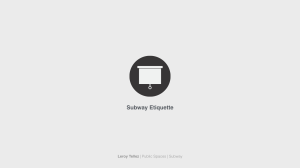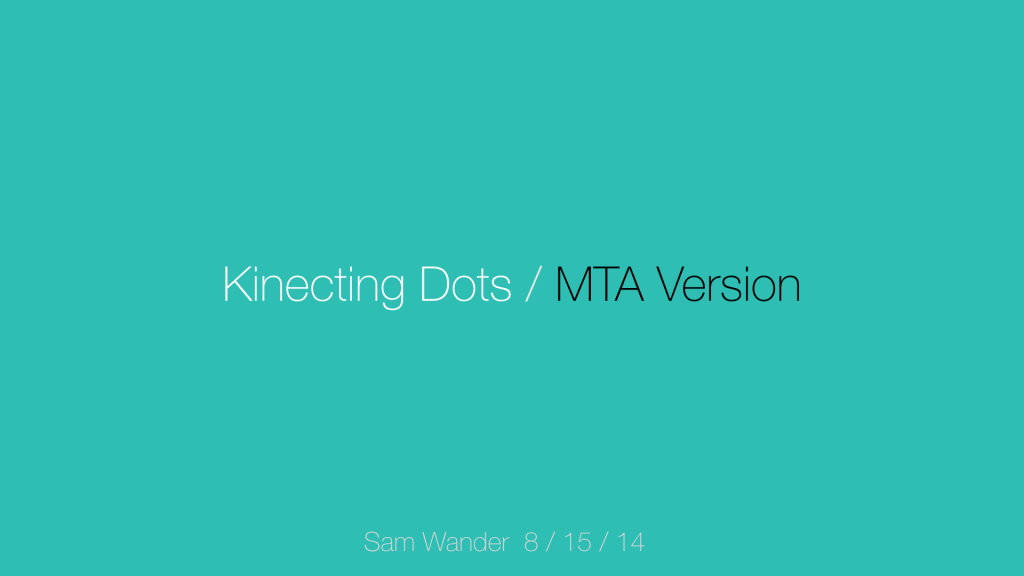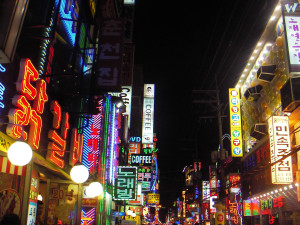The New York City subway system is always an adventure, and that’s mainly because you never know who or what you will encounter on your ride. However, those encounters haven’t always lead to any positive feelings. In my opinion how you act on the subway is a reflection of the type of person you are, and I have seen way too many reflections of just how disgusting and annoying people truly can be. So since I can’t force people to adopt more considerate values, I can create a way for those of us that practice positive subway etiquette to not have to see it.
Monthly Archives: September 2014
Subway Stirrer
Coffee, Juice, or Kale-Ginger Detox Smoothie. We are getting our drinks to go because we are so busy here in the city.
We get our drink. Walk to the subway. Wait for the train to come for 5 to 10 minutes, if not more. By that time your drink has settled and isn’t the way you had it originally. And that’s why I’m introducing the Subway Stirrer.
See the presentation here.
It can be a conversation piece between your fellow subway traveler, but more importantly it stirs your drink properly giving you a satisfying drink and a great subway experience.
Filed under Quick Indie Project
The subway as a platform for public health
For physical computing last year, I worked on a project that aimed to make light therapy easier and more accessible for people with Seasonal Affective Disorder (SAD).
When I first thought about how to bring this concept to the public transportation space, I wondered if lighting design could help the community-at-large get better sleep. Inspired by the simplicity of the flux desktop app that transforms your screen lighting into orange hues at night, I thought this model could apply to subway lighting as well.
Curious about how an environmental change like this might impact the well-being of a lot of people at once, I went a step further and asked what other ways the design of public transit could help shape public health. I used stress as a lens for 3 design intervention concepts.
[ Project Website ]
I experimented with presenting my ideas in a very quick and simple narrative website. To see the website, first download the folder, then double-click on the “stress-and-the-subway.html” file to open it in your browser.
– Melody
Filed under Quick Indie Project
Feel the weather on the subway
For physical computing I created a product that allowed you to feel what the weather was like all over the world inside a box. I reimagined this project and how people could interact with it while riding the subway.
Filed under Quick Indie Project
Dami on Third Places
I have a home (First place) in two different places. One is in Seoul, South Korea where I was born and raised and other one is in New York City that I live now. Ironically, though I lived in Seoul longer than here, there are no my personal stuffs anymore in Seoul. Also, although I visit Seoul, with a joy of visiting my hometown, once every two years, I even feel some nameless awkwardness when I sometimes realize that there is no my own space completely in the house. Can I say that the house in Seoul is my first place? Then what about New York where I currently live? I honestly can’t say that this is a home completely for me either. There is no family here, I’m not USA citizen, and more of my close friends are in Seoul. Nevertheless, the reason I can say that this city is my current home as well as my third place is because I am building my life here.
When I think about the things that gave me small joys, while leading a busy life, in the third places, they were the relationships with people that I have built and communications I have had with them. Although I now live alone, I have spent more time with my roommates in New York. They befriended me when I was lonely and were willing to listen to my stories. I believe, through the people I met in the shared space in New York, a completely strange place at the time, I have been able to establish a more stable life for myself here. I also have been keeping in touch with my friend from Denmark I met in a youth hostel 6 years ago. Despite the differences in destinations and places where we live and the fact that we hardly get to see each other, it seems that the Internet and SNS have enabled us to keep in touch each other. I believe the relationships in the third place I have built with the people around me, such as the people at my favorite café, the salad store staff, who remembered my name and gave me macaroon to try, and the middle-aged gentlemen I met at Central park, who gave me small tips on life during a short conversation we had, etc., are making my everyday life more diverse and warm.
Filed under Readings, Third Places
Kinecting Dots on the subway
I took some of the core concepts from a quantified self / data visualization project completed early last year and re-imagined them in the context of riding the subway.
Third Places
Thoughts can be found here : http://interactionjournal.tumblr.com/
Filed under Readings, Third Places
Effy on “Third place”
Filed under Third Places
Need for the third space in Korea
Filed under Readings, Third Places
On “Third Places” – Sunnie
While reading the “Third Places” by Ray Oldenburg, two “Third Places” (scenes) came into my mind.
“Third Place” 1
The company where I did my internship this summer is located at W4st and Broadway. During the internship, I walked pass the Washington Square Park almost every morning and afternoon. In such an interesting and vibrant “third place”, this is what I saw: every morning around 9, echo from the folk guitar singer under the Washington Arch welcomed my entering the park; a group of NYU students gathered at the same place as always for their field trips; in the open area surround by summer herbs, the yoga group lying in grid breathing the morning air; homeless people find their shelter under the trees, running squirrels and wandering pigeons knew not to wake them up from the dreams on the grass bed… After 6pm, the park became an even more amazing“third place”, novel reading hipsters, Disco dancing guys, the comedy performance group, jazz band, excited tourists, chilling office ladies, laughing kids with Uncle Bubble, doodle artists… The park is a miniature of NYC that you can find all kind of amazement out of this informal gathering community. It makes me smile. Within a city with dense popularity and mostly vertical structure living/working style, the park creates a horizontal, wide “sorting areas” for people have shared interests; a safe and tolerant place for people to express themselves; also provide a sense of belonging, “the social anchors of community life”, which is essential for such a melting-pot city.
“Nor is it a coincidence that the joie de vivre cultures of the world are those in which third places are regarded as just as essential as home and work”, as Ray states in the article, ‘Joy in living’ depends upon people’s capacity to enjoy the company of those who live and work around them.” The chemistry generated by the community interaction and conversation bring life to the city, becoming one of the uniqueness of NYC’s characteristic. I think being exposure in this diverse community also help preventing falling in the restriction of “home-to-work-and-back-again” shuttle, create a psychological openness of mind.
“Third Place” 2
About four years ago, my grand parents who are in their 80s, moved into a new multi-floor apartment building. My families all felt happy about this move because the building located in the new CBD of the city they live in; the apartment was much newer and bigger than their old apartment; a within-10-minutes walk to the river side and the super market. However, my grandpa felt depressed after he moved in. He kept visiting back to the old place that located in the old town near a train station. It used to be a community that all his old retired coworkers live in. Around the area were many small stores and restaurants along the street. In my memory the it was always crowded and chaotic.
I still remember our talk on their new balcony. “I went to my old home yesterday”, grandpa said. “Why going back again? It’s so far to take a bus from here and you must feel tired after such a long commute”, I asked. He said, “it’s still so good. I could just have a simple lunch in the corner restaurant. I could picked up a newspaper and read there, like I used to do everyday.” “But now you can stroll along the river and go to the super market, and the environment in this area is much better”. After a long while, he sighed, “People are gone. My old friends all move into new apartments around the city, we couldn’t play Majiong like the old days. I used to know all the people from those stores and restaurants, sometimes I chatted with them and their kids. Now I have no one to talk to. I don’t like supermarket… Sometimes I just felt lonely.”
I felt sad about how the new isolated urban living style rudely change the way the elderly, like my retired grandpa, used to live. As young people who has work and more social life outside of where we live, the apartment building is more of a space where we close the door and sleep. We spend our spare time elsewhere, but not for my grandpa. He can’t stay in front of the computer and TV all day like us. His routine is highly connected to the walk-distance community – the courtyard, newsstand, farmers market, tailored store, restaurant, with all the familiar connection – he need those people to build up his retired life, to spend time, to communicate information, to have neighbor’s help when emergency happened, and to have a spiritual support from the accompany that their busy younger families couldn’t provide. Perhaps it requires city designers in China of more empathy to design the “third places” for the elderly’s accommodation.
Filed under Readings, Third Places




